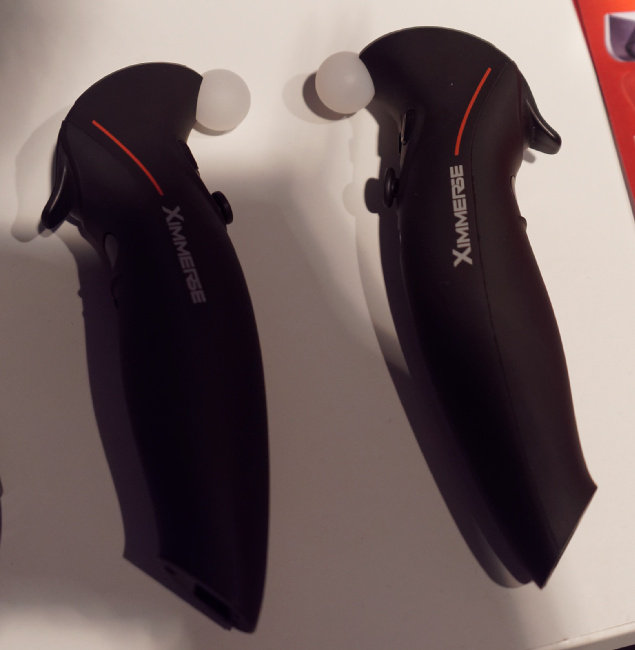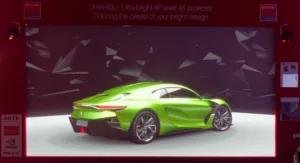Barco was showing a DP4K-60L 6P laser projector in a rear-projection mode and was highlighting the wide gamut support – it looked very good and was showing colours that would not have been visible on a typical Rec. 709 display. The company also highlighted to us that the better contrast of laser projection is almost as important as the colour boost. Barco also said that because it can deliver 80% of rated brightness at 30,000 hours, the lasers are ideal for intensive use, although, as we could see from the glass panel to the back of the booth, the light source is very substantial. The 6P technology can also support active Infitec and active shutter glasses for stereo operation. Barco is supplying 56K, 44K, 28K and 22K lumen output and we heard that a typical CAVE environment uses a 22K projector. Overall, Barco had 15 different projectors at the event.
Barco’s 6P Laser supports Rec 2020 which had impressive colour. Image:Meko
Christie had lots of projectors at the show, as well as some FPDs, as the company is a major sponsor of the event. The company had a demonstration of the Mirage 4K30 in an immersive solution with 3D tracking. The company had worked with French integrator and software developer, Lumiscaphe, which was showing its 3D software at the event. It was also working with Antycip Simulation.
Digital Projection was showing its laser-phosphor (L/P) projectors, the single chip DLP E-Vision Laser 8500 which was being shown with an ultra-short throw lens and dual Highlite Laser II three chip DLP projectors which were being used in an active S3D demonstration. Staff told us that this was the same as at ISE, but checking our records (and the Digital Projection website), we found that the 13K version that was on show, is not yet listed. The company told us that although it is sometimes asked about the cost of replacing Laser/Phosphor light sources, the expectation is that with a 20,000 hour lifetime, by the time projectors need new light sources, better and cheaper products will be available. The company also said that L/P is really helpful in multi-projector blended applications as the long life means that calibration is not needed so frequently. When bulbs are changed, these systems always need re-alignment. The company told us that the issues in the US with the FDA that came up over L/P last year concerning safety have now been solved.
Durovis has a smartphone-based VR headset system available in two sizes called the Dive 5 and Dive 7, which support 5″ and 7″ tablets. The company also supplies “cardboard-style” mounts and also very low cost systems that are customisable and designed to be given away.
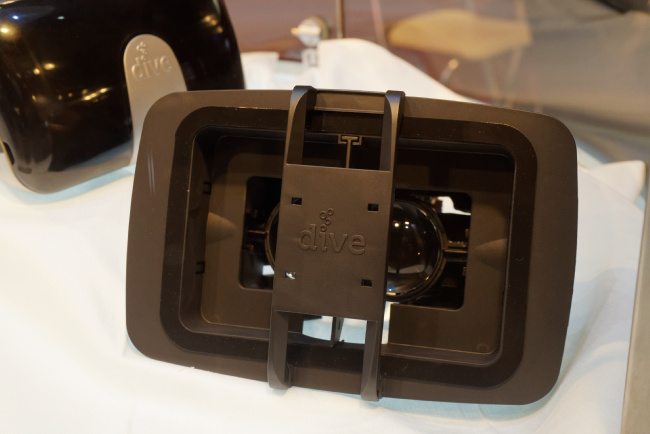 Dive’s VR holder can support a 7″ phablet. Image:Meko
Dive’s VR holder can support a 7″ phablet. Image:Meko
ESI was showing its IC.IDO software for product evaluation, physical simulation and design review. The software is used around the world by 200 firms and the company told us that Volkswagen has 25 rooms with the software, while Boeing has 10 rooms. ESI focuses on the software side and the company works with local hardware integrators. Barco and Christie are the most likely projection suppliers and the company told us that it has a range of CAVE solutions with 3 sided, 4 sided (used by Ford) and 5 sided (used by John Deere) systems in place.
![]() L’École de Design Nantes Atlantique was showing a project called “Inner Space” that uses VR to help teach biology. It has a connected breastplate that gives haptic feedback as its system shows how water passes through the body, looking at the organs that are affected.
L’École de Design Nantes Atlantique was showing a project called “Inner Space” that uses VR to help teach biology. It has a connected breastplate that gives haptic feedback as its system shows how water passes through the body, looking at the organs that are affected.
Eon Reality is a US-based contractor and integrator that set up in France around 18 months ago. One of its developments was to build a permanent immersive dome in Laval that can give an immersive experience to up to 24 people simultaneously by projecting onto a geodesic dome and adding to this with motion seats, scent sources, wind and mist to add to the experience. Unfortunately, we didn’t have time to try this – we’ll plan better next time! At the show, the company was showing a portable version of the dome that is suitable for up to five people and was being shown with a Barco projector with a special lens. There weren’t many details and pricing is still to be decided.

Epson had nothing new that we hadn’t already seen as the new Moverio was launched at MWC. However, in Laval, the company was highlighting the older BT2000 system which has been specifically designed for wearing over longer periods of time. The system uses a full head strap to spread the weight around the user’s head and the glasses are also easy to flip up out of the way when they are not being used. We also heard that the new 300 system will be available in October.
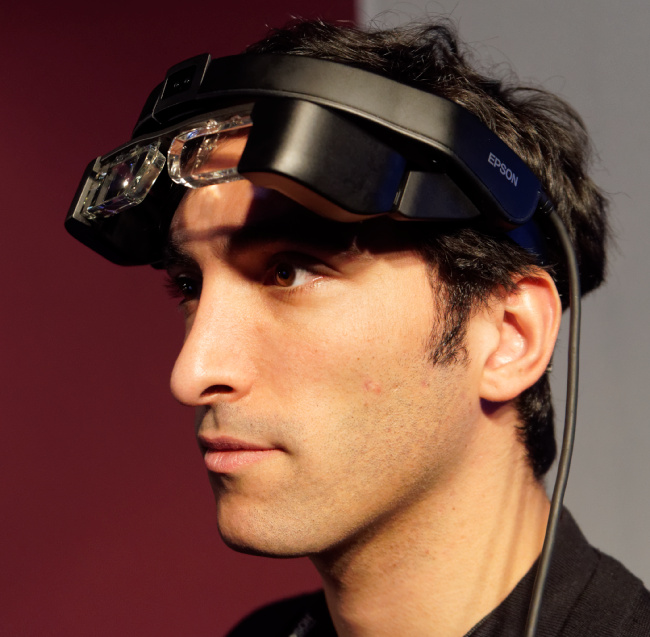 Epson’s glasses can be flipped out of the way. Image:Meko
Epson’s glasses can be flipped out of the way. Image:Meko
Eurological is a systems integrator that was showing Optinvent’s glasses.
 Giroptic was showing a 360 degree camera which uses three lens/sensors to give 360 degree horizontal coverage, with around 300 degrees vertically. The video is combined in the camera to a single stream that is recorded to local memory. The camera can also be used for live streaming when fitted with a PoE base unit and the individual streams are stitched before streaming. We were unable to get a clear answer on the level of latency for this. Still images are created at UltraHD resolution, while video is in 1920 x 1080. The cost of the camera is €499 including tax and should be available at the end of April.
Giroptic was showing a 360 degree camera which uses three lens/sensors to give 360 degree horizontal coverage, with around 300 degrees vertically. The video is combined in the camera to a single stream that is recorded to local memory. The camera can also be used for live streaming when fitted with a PoE base unit and the individual streams are stitched before streaming. We were unable to get a clear answer on the level of latency for this. Still images are created at UltraHD resolution, while video is in 1920 x 1080. The cost of the camera is €499 including tax and should be available at the end of April.
Haption specialises in simulation with haptic feedback and was showing a VR system that tracks the force needed for different procedures in physics-based models. The company’s simulations can show how particular operations might mean difficult ergonomics or excess force being needed for an operation – at the show it was showing how a torque wrench operation to tighten a bolt on an engine.
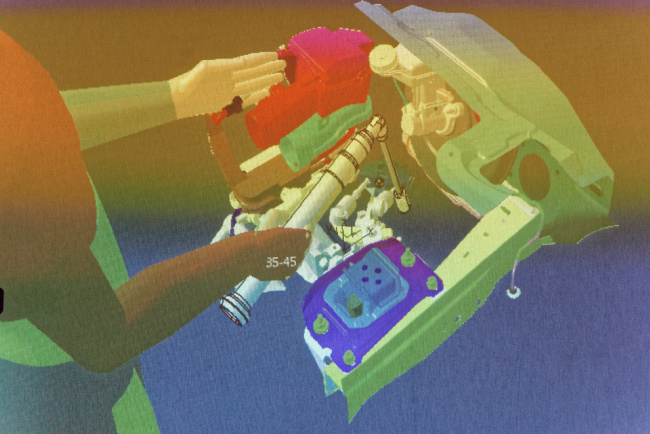 Haption showed this torque wrench simulation. Image:Meko
Haption showed this torque wrench simulation. Image:Meko
Holusion is from Lille and was showing ‘holographic’ (well, Pepper’s Ghost-based) presentations of products. The company also works with museums and educators – for example, one of its earliest projects was for a medical school that wanted a system to show all four sides of bodily organs. As well as the optical system, the company offers projection mapping technology.
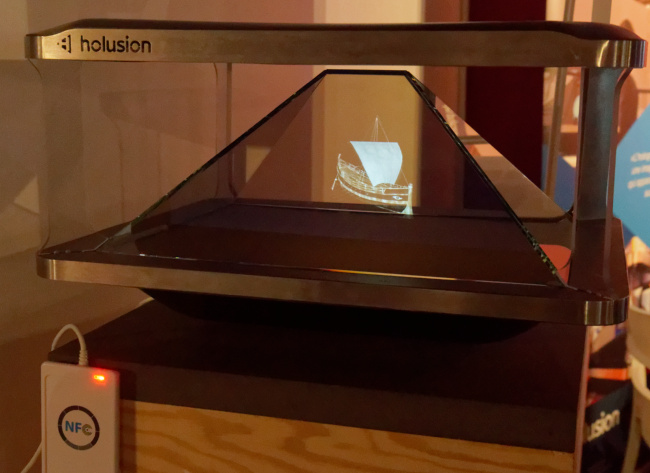 Holusion’s Displays are used in museums, retail and education. Image:Meko
Holusion’s Displays are used in museums, retail and education. Image:Meko
HP was demonstrating the Sprout Pro which will be available in March, having been launched at BETT. The company told us that the SDK for application development has been released. A feature that was getting attention was the HP MyRoom collaboration technology, which allows users to scan objects in 3D and collaborate on the objects. Although the original Sprout is being sold through mainstream retail outlets, the Pro is being solely through authorised resellers in France.
HRV is using 3D and VR to develop training applications in dentistry and medicine. There was a system using a controller that was showing students how to carry out dental procedures.
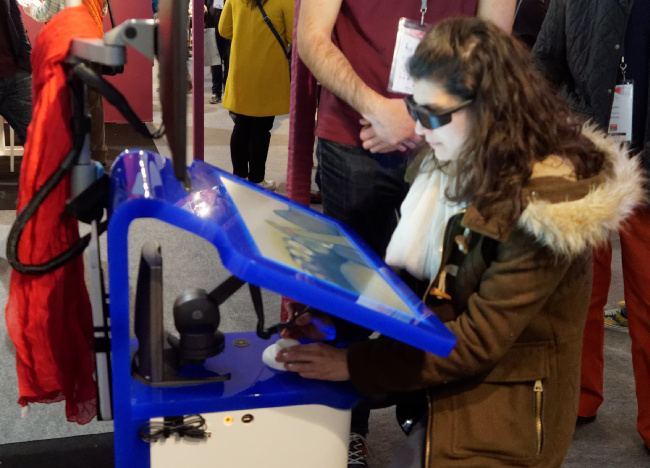 This 3D system was being used for dental training. Image:Meko
This 3D system was being used for dental training. Image:Meko
HTC had a largish stand with users trying the Vive system that we have previously reported on.
Ligo is a project to help the visually handicapped. At the moment, it is an academic project. Members of the development team found that, first, the visually handicapped tend to have to carry multiple electronic devices for different applications (e.g. checking colours of clothing). Further, typical smartphones have smooth touch interfaces that give few clues as to what is going on for the visually handicapped. The project team has developed a set of “buttons” that are based around different textures and geometric patterns that fit into a general purpose frame and can be used to trigger particular specific functions. The idea is that a user can configure the device for a particular time period e.g. going to work or going shopping by loading the specific textured modules.
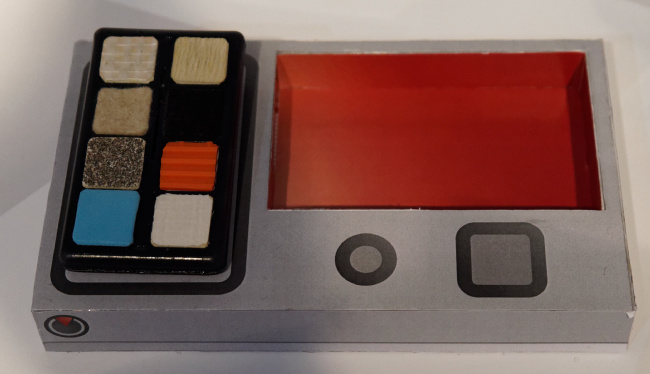
Lumiscaphe is behind many of the adverts and images that you may see of new products especially cars. The company supplies rendering software that can support sophisticated lighting and textures that can make photo-realistic images. The software is often used in design reviews. The firm has offices in France, the US and Japan.

Montreal University was showing a system, called DesignAR, it has designed for enabling users to draw, very simply, a floor plan on a piece of paper and combine this with small card tokens representing items of furniture to develop virtual spaces that can be quickly used to plan furnishings or room layout by being imported into a V/R application. The project team tried to make the system real time, but found it has lags of 200ms or so, partly because the Google Project Tango tracker has a minimum latency time of 30ms.
OpenSuitVR is an open-source project to develop a set of clothing that can give tactile sensations that reflect actions in VR environments. The group explained that it might, for example, allow a wearer to feel “the impact of a bullet” on the body in a first-person shooter game. The suit talks to the host system (usually a smartphone) via BlueTooth. More details at opensuitvr.com (although there was not much there when we had a look!)
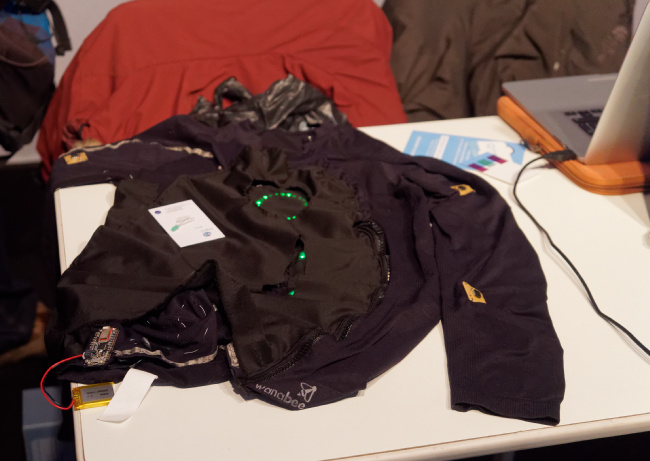 The OpensuitVR project is designing active tactile clothes
The OpensuitVR project is designing active tactile clothes
Qoom is an unusual projection-mapping project, developed by Tokyo University, that uses multiple (four BenQ and one Barco) projectors around an area to map images onto the surface of a ball that is fitted with touch and other sensors (gyroscope/acclerometer) to allow its position and orientation to be tracked. The projectors put images onto the “panels” of the ball which can then be used as an input system for a range of different playing and leisure applications. The position of the ball is tracked by cameras associated with each projector. The panels of the ball are enabled with touch sensors, but the circuitry is kept as light and as simple as possible to allow the ball to be used as a ball. Data is sent to a controlling system using wireless technology.
 Qoom had an interactive ball – the image on the ball is from a projector, but are not shown in our photo. Image:Meko
Qoom had an interactive ball – the image on the ball is from a projector, but are not shown in our photo. Image:Meko
Reality Tech was in the start-up area and was showing the use of microprojectors with cameras to develop toy and play activities that are somewhere between the completely virtual worlds of games consoles, and traditional toys. There was a very small projection onto a toy house, made of Lego. There was an area of the toy that was intended to be a TV and part of the surface was a video texture, so that video was showing on that part of the model. The firm wants to get into the projection business and has a target price for camera and projector of €500 including tax.
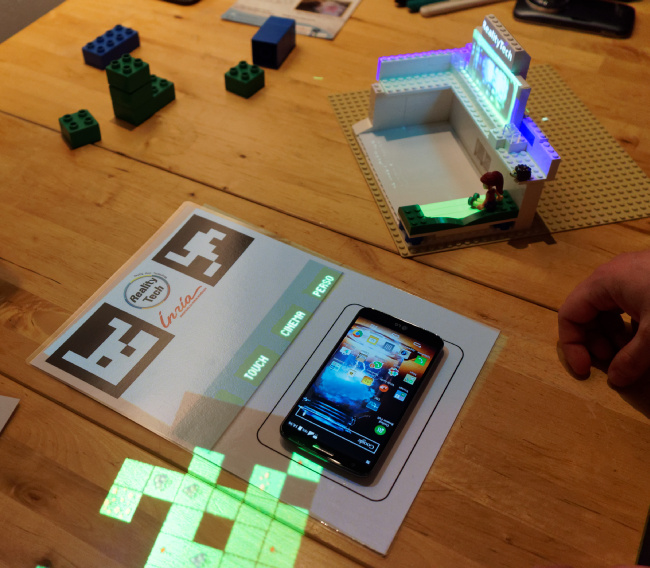 Reality Tech has a toy system. The house at top right was showing a video. Image:Meko
Reality Tech has a toy system. The house at top right was showing a video. Image:Meko
Realyz, which is based just outside Laval, and has a range of VR and A/R was showing an LCD-based mobile VR system, the Etablyz, that uses two LCDs at right angles to create a large display surface that can be interacted with using a VR contoller to control objects in the virtual world. For a video showing the unit in operation, check the video at http://tinyurl.com/jpu4tmc The system can be rented and takes just 20 minutes to set up (from €1,000 per day), or the company is happy to supply systems for purchase at prices, from €8,000.
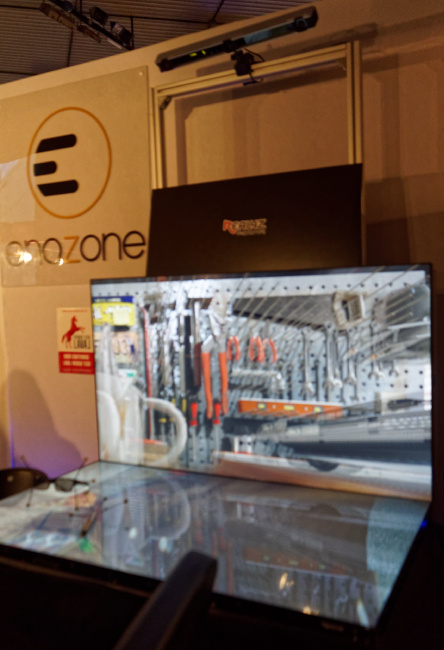 The Realyz 3D Table uses dual LCDs
The Realyz 3D Table uses dual LCDs
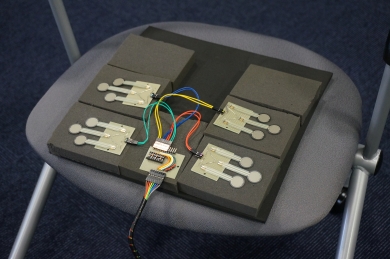 Ritsumeiken motion seat uses pressure pads. Image:Meko
Ritsumeiken motion seat uses pressure pads. Image:Meko
Ritsumeikan University of Kyoto, Japan, had a novel system for moving in virtual worlds. The system uses pressure pads in a cushion under the buttocks and thighs that are operated by a sitting person to initiate movement in the virtual world. The developers told us that one reason for developing the idea is the lack of space in Japan, so activities are best conducted in the space that a sitting person takes up. The speed of moving from side to side controls the pace of movement, while direction is currently set by weight leaning/balance and by turning the head. Small amounts of head rotation mean that motion is straight ahead, but larger movements in the head will trigger a change of direction. As well as gaming and entertainment, the technology could have applications in helping with rehabilitation and assistance systems for people with disabilities.
See http://tinyurl.com/zstu9ut for a video of the sensor.
Robocortex was showing its AugmentedPro software in a demonstration of a system for making wiring looms. The software was using a tablet (although a projector is also supportable) and an interesting feature was that as each time the cable was put through a correct loop, this was marked as correct. When mistakes are made, alerts can be triggered. When a correct move was made, the system automatically took a databased and timed photograph, which provides an automated audit trail.
 Robocortex had a demo of wiring. If the wire is incorrectly laced, the system advises. Image:MekoRitsumeiken motion seat uses pressure pads. Image:Meko
Robocortex had a demo of wiring. If the wire is incorrectly laced, the system advises. Image:MekoRitsumeiken motion seat uses pressure pads. Image:Meko
Scalee has developed a low cost ScaleeVR system that is based on consumer/mass market projectors and Kinect sensors and is aiming the system at people in construction and real estate. It is working with companies developing 3D scanning software to create a complete system that allows homes to be scanned, for example for real estate agents or for construction and design (especially re-modelling and conversions). A typical system costs around €5,000 and this makes it very accessible for a range of different users.
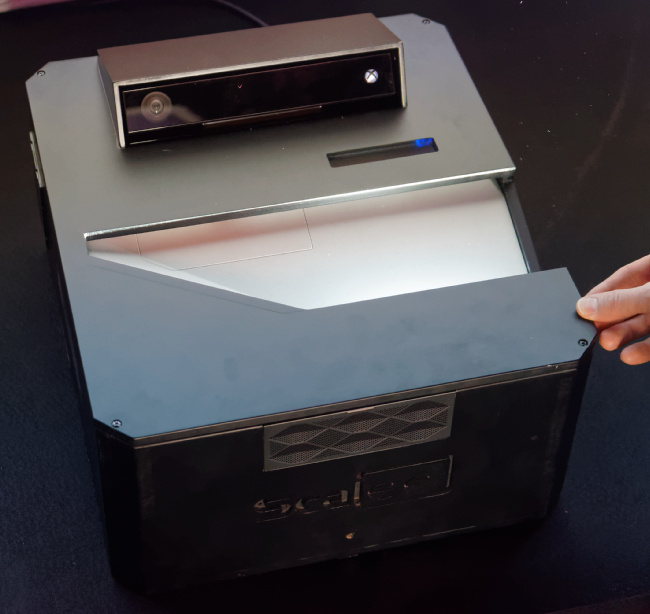 Scalee wants to sell this complete AR System for €5,000. Image:Meko
Scalee wants to sell this complete AR System for €5,000. Image:Meko
Senso is an Italian start-up from Padua and has a patented system using multiple micro-projectors to map onto objects in retail applications. The projectors are concealed in the casing system and the company told us that it is planning to add touch interactivity later.
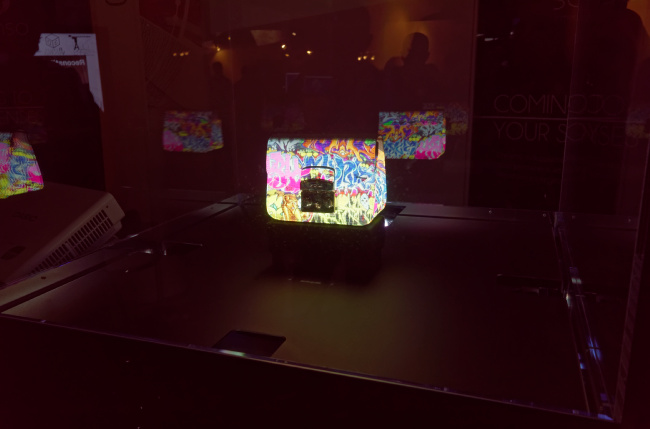 Senso’s projection mapping system uses four hidden projectors. Image:Meko
Senso’s projection mapping system uses four hidden projectors. Image:Meko
Smartpixels is a Paris-based start-up that has been going for just 8 months and was at the recent Retail Technology Expo in London, although we didn’t spot them there. The company has developed projection mapping technology including a projector hidden in a light fitting. The company uses “target” patterns to align the position of its projection and these targets are detected by a camera.
![]()
Stanford Computer Science Dept has a project, called Spectrum VR, that is being developed with colleagues from the Stanford School of Medicine that is being developed specifically to help children with autism to develop social skills.
TechViz is a supplier of VR and 3D simulation software that aims at professional applications. The company was demonstrating along with partners including Panasonic, HP, PNY and Nvidia
![]() Tobii was at the show to demonstrate how its Pro Glasses could be used to track viewer focus, although we were slightly surprised, on reflection (ouch! – Man. Ed.) that the firm wasn’t showing how its tracking technology could be used for foveated rendering etc.
Tobii was at the show to demonstrate how its Pro Glasses could be used to track viewer focus, although we were slightly surprised, on reflection (ouch! – Man. Ed.) that the firm wasn’t showing how its tracking technology could be used for foveated rendering etc.
A group from Tokyo University was using thermochromic paper (which uses heat to create a temporary image) to create instant photos. However, it was very sensitive to temperature and was not working for part of the day and, when we went by again, was producing an image of sorts, but not of the subject!
VRGo was in the start-up area and has a bluetooth-enabled backless chair that can be used in VR applications. By tilting and spinning on the chair, motion in a VR app can be controlled. The cost is under €300 and the company has a Kickstarter project. http://tinyurl.com/zsaye6x Shipping should start in Q2.
 VRGo’s movement seat can be used to control VR
VRGo’s movement seat can be used to control VR
XImmerse is from Guangzhou, China and has developed the X-Hawk dual camera system and X-Cobra hand controllers for use with GearVR/Oculus Rift etc. The controllers allow input with six degrees of freedom and without any significant usage of the processing in the host smartphone or system. The handsets talk to the host using bluetooth LE and sends finalised details of the controller movements. The units shown at the event were prototypes and volume production is expected in Q3 2016 with a target price for the camera plus controllers at $150.
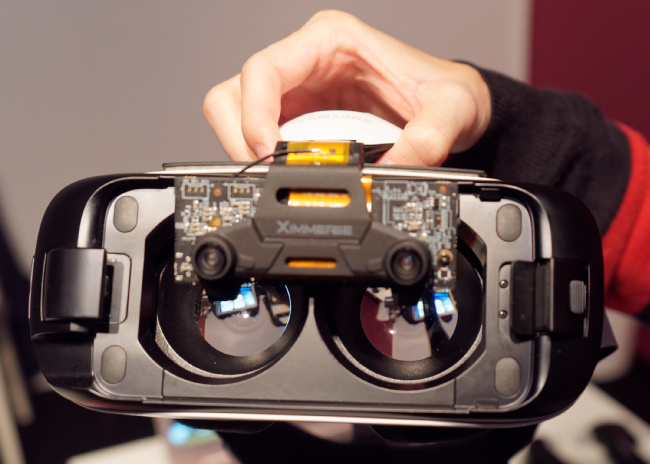 XImmerse’s camera is designed to be used to add controllers (below) for A/R to VR glasses. Image:Meko
XImmerse’s camera is designed to be used to add controllers (below) for A/R to VR glasses. Image:Meko
